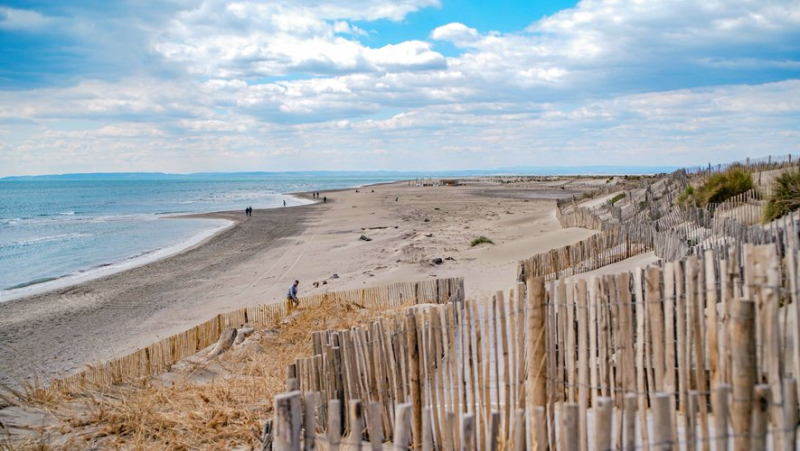At L’Espiguette, we are focusing on a gentle and natural restoration of the dunes to cope with the onslaught of the sea.

Le cordon dunaire a été renforcé et sécurisé de façon naturelle. Midi Libre – Mikaël Anisset
Sur le secteur des Baronnets, la plage a reculé de 50 m en huit ans. Ce projet entièrement naturel a été lauréat national d’un appel à projet du ministère de la Transition écologique. Une autre approche pour maintenir le trait de côte.
Just a few days ago, on this Baronnets site, east of Espiguette, a good part of the beach had been "swallowed" by several successive sea waves in recent months. "It’s simple, the staircase to go down to the beach from the top of the dune fell into the void" explains a Graulen. Emergency work made it possible to restore the dike and reestablish several meters of beaches, but these episodes serve as a reminder of how this sector of Espiguette is a sensitive point in terms of erosion and risk of submersion. Here, between 2015 and 2023, the beach has retreated by approximately 50 m with between 2 and 15 m being nibbled away per year.
A real risk of marine submersion
This sector has just benefited from work aimed at restoring the back of the dune cord to protect the natural environments and human activities located behind it. back. The inauguration of the restored site took place this Tuesday, April 24 in the presence of numerous elected officials, State representatives including the regional prefect Pierre-André Durand, of Symadrem who carried out the ;nbsp;works, companies and organizations associated with coastal protection.
"This site was identified as a point of weakness" specifies mayor Robert Crauste, "in particular with an opening, an old access to the beach, which constituted a risk of intrusion from the sea in the event of a storm. Marine submersion would threaten human activities like the Sables vineyard, which has just obtained AOP, or even industrial sites like the Salins or the six fuel tanks classified Seveso 2 and could reach low points adjacent to urban areas.

Mayor Robert Crauste explains the latest sea surges to regional prefect Pierre-André Durand. Midi Libre – Mikaël Anisset
The Grau du Roi town hall was one of the nine national winners of a call for projects launched in 2019 by the Ministry of Ecological Transition for solutions. ;nbsp;based on nature for resilient coastal territories.
The mixed interregional union for the development of the dikes of the Rhône delta at the sea (to which the community of communes Terre de Camargue has entrusted Gemapi management) has been entrusted with ;nbsp;the completion of this work during 2023, on a sensitive site (Grand Site de France, Natura 2000 Zone…)
Symadrem explained the work carried out
"Work the amount of which is not very high, but which is exemplary"specified the regional prefect, emphasizing that monitoring and feedback of experiences on this site would fuel national reflection on the management of the coastline and new calls for projects.
Controlled access to the beach
Espiguette beach is an exceptional site which attracts a lot of people in summer. Access to the beach will therefore be controlled and developed with access only via a path and a staircase in the sand allowing you to cross the dune. Public awareness is raised through the installation of educational panels. It is of course forbidden to walk on the dune cord…hellip;
The president of Symadrem Pierre Raviol and his director Thibaut Mallet detailed the work carried out. invasive. Then sandy reloading made it possible to double the width of the dune cord (from 30 to 60 m). Ganivelles were laid and then mulching ;installed (with Saint-Gilles sagne) to prevent erosion of the dune by the wind. Dune plant species were then planted to fix the dunes. It’is a combination of gentle techniques, quite simple and environmentally friendly".
"We stop facing the sea head-on"
Techniques which succeed traditional sea groynes and systematic riprap."The riprap is still essential sometimes but today, generally speaking, we stop facing the sea" < /em>adds Robert Crauste. "We must learn to live with the sea rather than fighting against it" agrees with the regional prefect.
Because all the speakers are unanimous: this experiment can only be seen as a temporary solution, pending the interregional strategy of intervention on the’ nbsp;coastline, currently being developed by Symadrem.
The equivalent of a stadium disappears every week on the French coast
Even more so than at the beginning Espiguette, the sea is prankish… With silting on one side (the famous sandbank) and significant erosion on the other. "A different expression of the same inevitable phenomenon: every week, the equivalent of a football field disappears on the French coast& ;hellip; It is therefore a question of organizing ourselves, of experimenting step by step and of going beyond the sole logic of the fight against the sea" concludes Pierre-André Durand .
Cost of work 120 175 € Excl. VAT including 70% funding from the State and 30% from Symadrem.




